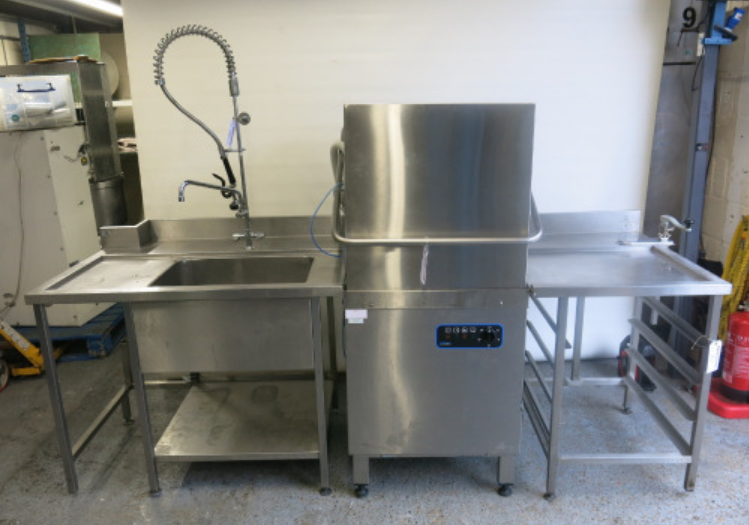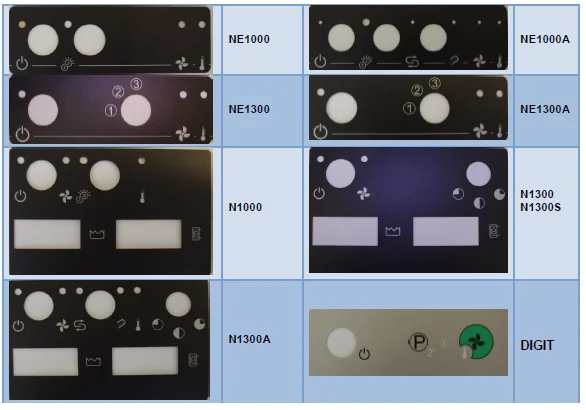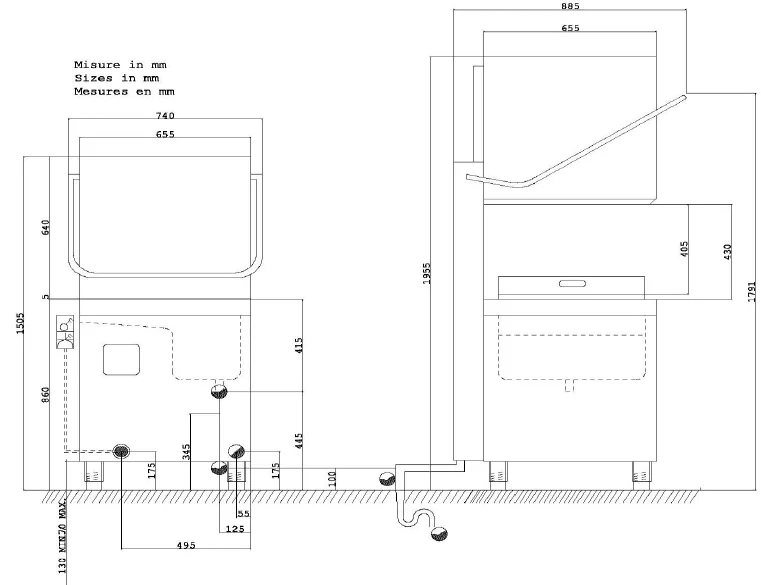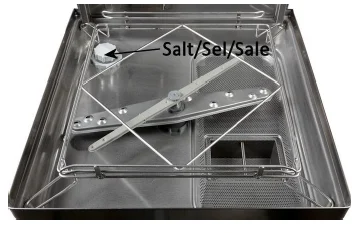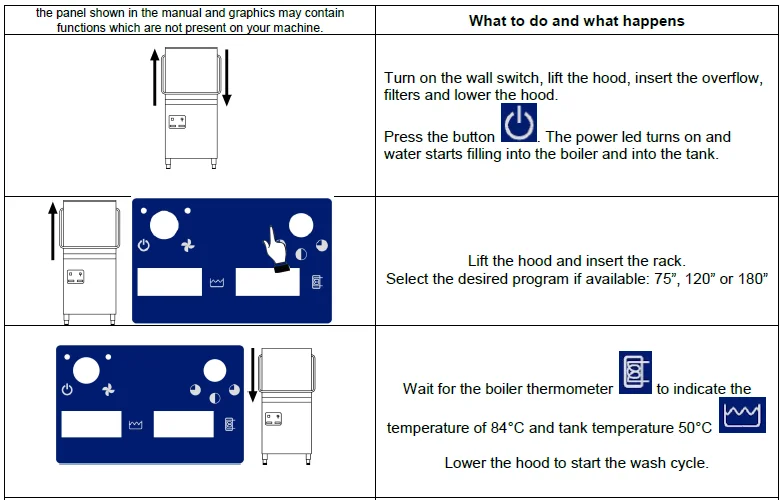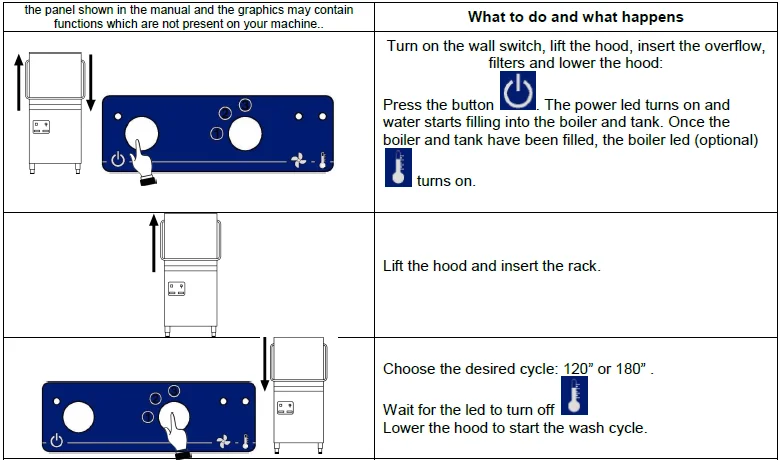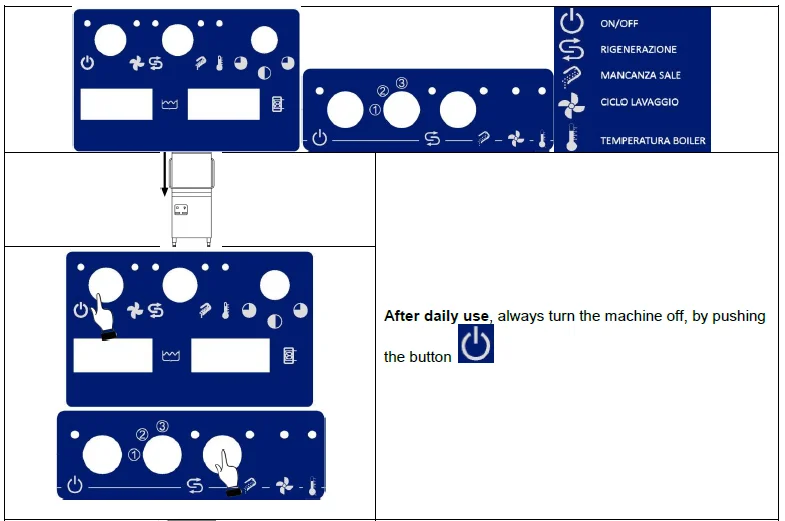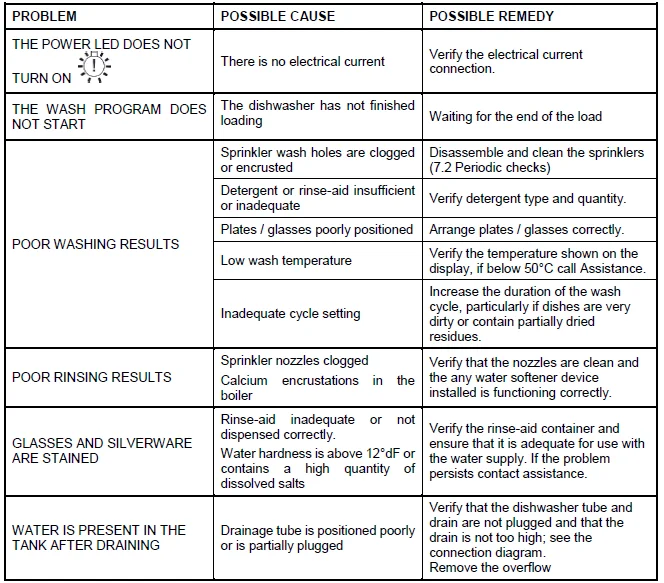
Adexa ADX10T Pass Through Dishwasher
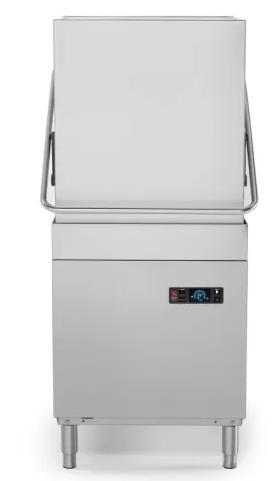
Controls
Control chart
USE AND SAFETY WARNINGS
Installation
POSITIONING, CONNECTIONS, ACTIVATION, TROUBLESHOOTING, AND REPLACEMENT OF THE POWER CABLE MUST BE PERFORMED BY QUALIFIED PERSONNEL.
THE GROUNDING CONNECTION IS OBLIGATORY, IN ACCORDANCE WITH THE METHODS PRESCRIBED BY THE SAFETY NORMS OF THE ELECTRICAL SYSTEM
Use
THE DISHWASHER IS INTENDED EXCLUSIVELY FOR PROFESSIONAL USE AND MUST BE USED BY AUTHORIZED PERSONNEL. IT IS DESIGNED TO WASH DISHES (PLATES, CUPS, BOWLS, TRAYS, SILVERWARE) AND SIMILAR ITEMS USED IN THE GASTRONOMIC OR PUBLIC CATERING INDUSTRIES, IN CONFORMITY WITH INTERNATIONAL ELECTRICAL, MECHANICAL SAFETY (CEI-EN-IEC 60335-2-58/61770) AND ELECTROMAGNETIC COMPATIBILITY (CEI-IEC-EN 55014-1/-2, 61000-3;4, 50366) NORMS.
Non-compliant use
THE MANUFACTURER DECLINES ALL AND ANY LIABILITY FOR DAMAGE TO PERSONS OR PROPERTY CAUSED BY FAILURE TO COMPLY WITH THE INSTRUCTIONS SET FORTH BY THIS MANUAL, INCORRECT USE, TAMPERING, EVEN WITH A SINGLE PART OF THE MACHINE, AND USE OF NON-ORIGINAL SPARE PARTS. IN CASE OF DAMAGE TO THE POWER SUPPLY CABLE, THE SAME MAY BE REPLACED ONLY BY THE MANUFACTURER, AN AUTHORIZED CUSTOMER CENTER, OR A QUALIFIED TECHNICIAN.
Safety notes
- DO NOT PLACE SOLVENTS SUCH AS ALCOHOL OR TURPENTINE IN THE MACHINE, SINCE THESE COULD CAUSE AN EXPLOSION. DO NOT PLACE DISHES CONTAINING ASH, WAX, OR RESIDUES OF VARNISH IN THE MACHINE.
- NEVER USE THE DISHWASHER OR ANY PARTS THEREOF AS A STEPLADDER OR SUPPORT FOR PERSONS, PROPERTY, OR ANIMALS.
- LEANING OR SITTING ON THE OPEN DOOR OF THE DISHWASHER MAY CAUSE THE MACHINE TO TIP, ENDANGERING PERSONS CLOSE TO THE SAME. DO NOT LEAVE THE DISHWASHER DOOR OPEN TO AVOID TRIPPING.
- DO NOT DRINK WATER WHICH REMAINS ON DISHES OR THE DISHWASHER AFTER A WASH CYCLE.
- THE MACHINE MAY NOT BE USED BY CHILDREN OR PERSONS WITH PHYSICAL, SENSORIAL, OR MENTAL DISABILITY, WHO LACK THE NECESSARY EXPERIENCE AND KNOWLEDGE TO USE THE SAME. THE MACHINE MAY BE USED BY SUCH PERSONS ONLY UNDER THE SUPERVISION OF A PERSON RESPONSIBLE FOR THEIR SAFETY.
Waste recycling
THIS MACHINE IS MARKED IN CONFORMITY WITH EUROPEAN DIRECTIVE 2002/96/EC, WASTE ELECTRICAL AND ELECTRONIC EQUIPMENT DIRECTIVE (WEE).
PROPER DISPOSAL OF THIS PRODUCT HELPS TO PREVENT ANY POTENTIAL NEGATIVE IMPACT ON HEALTH AND THE ENVIRONMENT. WE DECLARE THAT THE SOUND EMISSION PRESSURE LEVEL LPA IS 62 DB/A WITH UNCERTAINTY EQUAL TO KPA + 1 DB. THE SOUND POWER LEVEL IS LWA 73.79 WITH UNCERTAINTY EQUAL TO KWA + 1 DB
Installer’s instructions
The following instructions are addressed to qualified technicians, who are the only persons authorized by the manufacturer.
THE MANUFACTURER DECLINES ANY RESPONSIBILITY FOR DAMAGE TO PERSONS OR PROPERTY CAUSED BY INSTALLATION BY UNQUALIFIED INSTALLERS, AND/OR BY THE USE OF NON-ORIGINAL SPARE PARTS.
Integrity of Packaging
Please check that the packaging is undamaged, and after unpacking the machine, check that it has no dents. In case of visible damage, please contact your seller.
Before installation
Before the installation, please ensure that:
- The floor has a drain hole with Ø of 100 mm.
- You use an H07RN-F-type- type power cable (supplied by the factory) and ensure that there is a mains electrical power switch, complying with the characteristics of the machine, within easy reach of the dishwasher, so that you may disconnect the machine from the mains after use (see 6.5)
- You connect the water supply to a ¾” threaded gas outlet.
Use only new pipes for connection to the water supply; old or used tubes must not be used.
A general faucet must be installed on the water supply input tubing; the faucet must be accessible after installation. Do not install the faucet behind the dishwasher.
Check the amperage and voltage rating of the machine you intend to buy (see datasheets on our website), to ensure that your power supply is appropriate.
Pursuant to applicable laws, the user must install a mains electrical power switch and a differential switch compatible with the characteristics of the machines.
These switches must be installed near the dishwasher, be easily accessible after installation, and guarantee complete disconnection from the power supply in category III overvoltage conditions.
Connection diagram
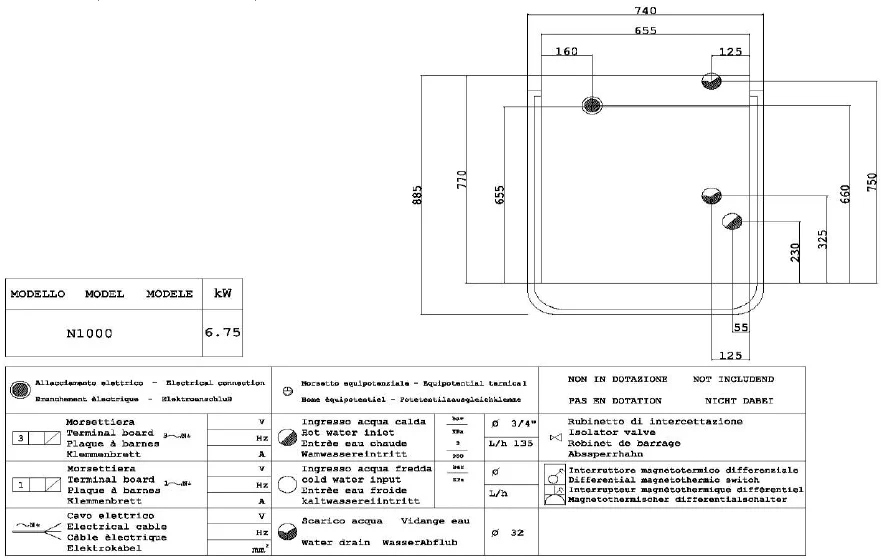
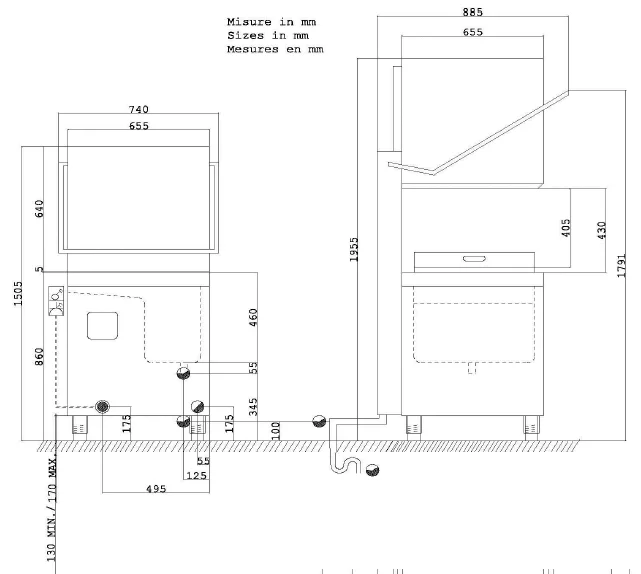
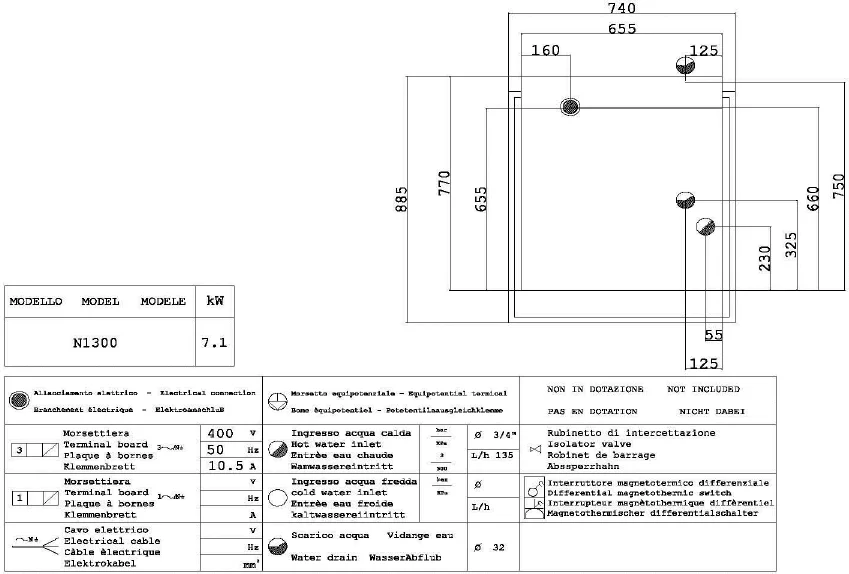

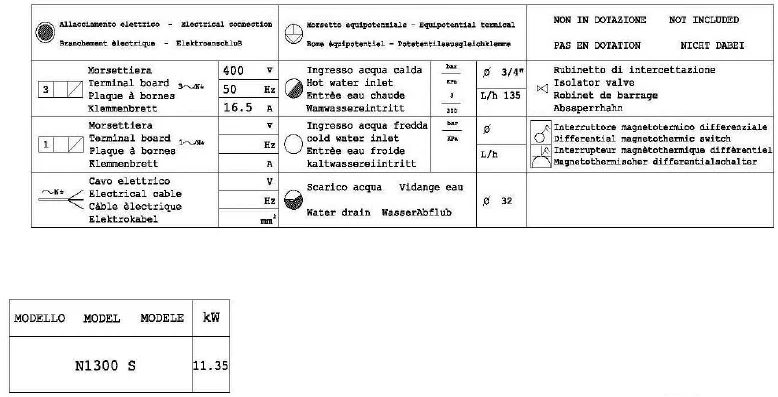
Installation and positioning
Position the dishwasher in the required position and remove the wrapping.
Ensure that the four feet of the dishwasher are perfectly level (using a level), regulating the feet so that the dishwasher is perfectly stable; any other solution must be approved by the manufacturer. Once the position has been positioned correctly and stably, we recommend that you fix all legs to the ground as shown in the picture below.
Please refer to point 4.3 for correct wiring.
Electrical connection
For the electrical connection, use only the electric cable supplied by the factory
CONNECT THE APPARATUS TO THE USAGE EQUALIZER
The connection clamp is at the bottom of the back of the machine.
The earthing conductor (PE) is yellow-green, the neutral conductor (N) is blue, and the phase conductors (L1, L2, L3) are black, gray, and brown
Water supply and drainage
The water pipes are on the back of the machine (V. 6.3). The water supply should be connected to a ¾” threaded gas outlet.
Drain: The machine is fitted with a drainpipe, which should be connected to the drain.
If the drain is on the floor, the machine may be connected to a Ø 100 mm drain hole. If the hole is higher (on the wall), you should install a Drain Pump (installation of a Drain Pump is mandatory when the drain hole is higher than that of the machine).
Caution: after completing installation, ensure that the water supply and drain pipes are not bent or compressed.
Water Supply characteristics:
Pressure:
For your machine to function efficiently, the water pressure should be between 2 and 4 bar.
If the water pressure is lower, the Rinse Booster Pump (internal or external) should be installed. If the water pressure is higher, a restrictor valve should be installed.
Water Hardness:
The ideal hardness is between 7 and 12˚.
If the water hardness is above these values, an internal or external softener should be used (see 5)
Temperature:
Hot water supply: recommended, provided the temperature does not exceed 60˚C.
Do not use hot water (>30 ˚C) if the machine is equipped with a water softener.
Cold water supply: OK, provided the electrical power supply is sufficient to guarantee the wash and rinse cycles at a temperature of between 55˚C and 82˚C, which may be guaranteed by an Atmospheric Boiler and a Rinse Booster Pump.
NB, please note that if the washing machine is equipped with a water softener, the temperature of the water inlet must not exceed 30˚C.
OPERATING TEMPERATURE
Wash / Rinse: 55°/ 85°C
DO NOT TAMPER WITH THE TEMPERATURE ON THE THERMOSTATS
Set up
Important:
The rinse-aid dosing unit is a standard on all models, while the detergent dosing unit is optional.
If your machine is equipped with both dosing units, insert the external detergent and rinse-aid containers and insert their respective suction tubes at the back of the machine.
- Red tube: detergent
- Transparent tube: rinse-aid
Before inserting the tubes into the containers, apply the weights (necessary to keep the tubes at the bottom of the container) and the filters as indicated in the diagram (2).
For adjustments, use the adjustment screws as indicated by the diagram.
The adjustments should preferably be made by personnel of the company that supplies the detergent.
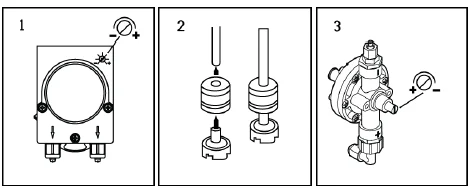
Rinse aid and detergent
Safety notes
ALWAYS FOLLOW THE MANUFACTURER’S DIRECTIONS
USE ONLY PRODUCTS SUITABLE FOR INDUSTRIAL WASHING MACHINES. NEVER MIX DIFFERENT PRODUCTS
Rinse aid
The Rinse Aid ensures almost instant drying of your dishes, and is always supplied as a standard part of the machine. It is dosed by a pump (Set up 4.7)
Detergent
The Detergent Doser is generally supplied as an option.
If the machine does not have a detergent doser, you may buy a separate kit (request information from the technical assistance department).
Filling and dosing
During refilling, do not mix products, since this may affect washing results. Never mix different detergents, since this may damage the dosers.
Industrial detergents may cause irritation. Before handling, read the instructions on the package.
Dishwashers without a detergent doser: place the detergent into the washing tank, every 4-5 washing cycles (for quantities, refer to your supplier)
Water softener (optional)
If water hardness is above 12°F, we recommend the use of a water softener. (Remember that the temperature of the water inlet should be <30°C)
Low salt warning (optional)
To ensure the best from your machine, we recommend filling the tank as soon as the “low salt warning lamp” turns on (6.2).
Topping up the regenerating salt
Warning: Use only specific regenerating salt and never cooking salt.
The tank has a capacity of 1kg
The container is on top of the box. Unscrew the cap and refill when there is no water in the tank in order to keep wash water from entering the water softener device; always unplug the power cable from the socket before performing this operation. Remember to plug the power cable into the socket after performing this operation.
Operating Instructions
Loading
Water should be loaded, with the hood closed
- Plates: The basket can contain 12 bowls or 18 flat plates. Remove solid residues from the dishes (bones, peels, cores, etc.); before washing, soak dishes with residues of dried cheese, egg, etc. in cold water.
- Glasses: Position glasses upside down.
- Cutlery: Use the cutlery basket. Large amounts of silverware should be placed with the handles facing down, making sure that you do not injure yourself with the fork prongs and knife blades.
Use on model NE1000 – NE1300
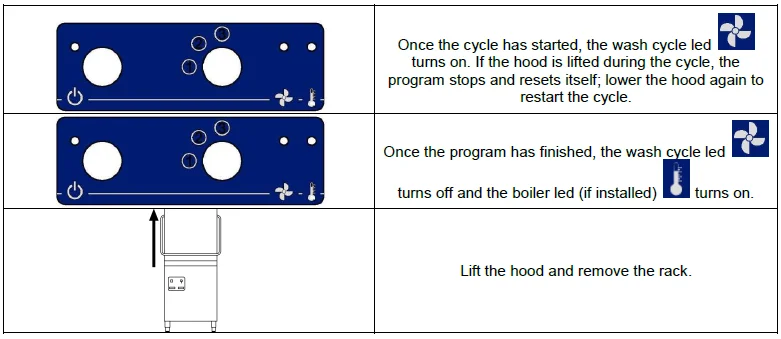
Use on model N1000 – N1300 – N1300S
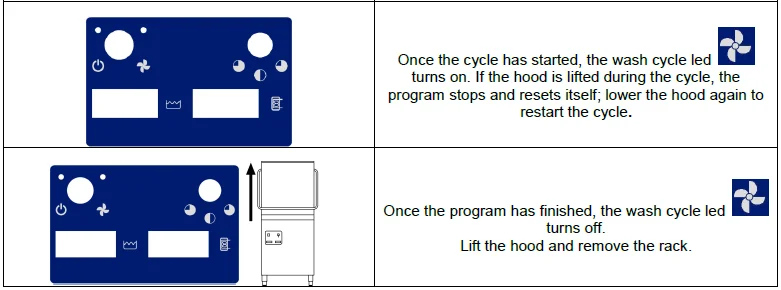
Use on the model DIGIT
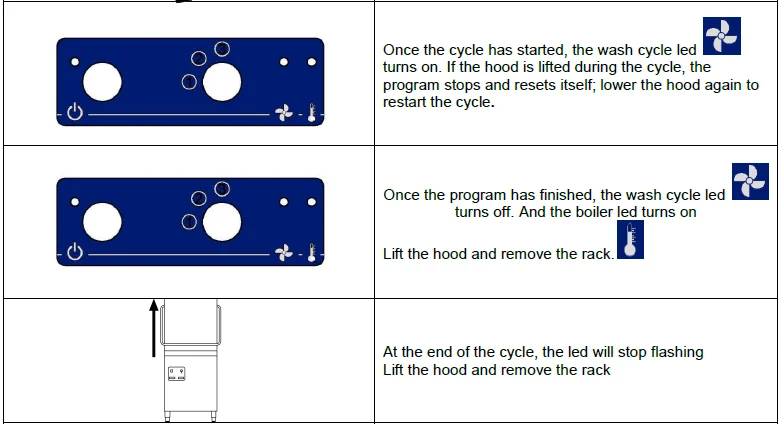
Regeneration cycle

N.B. DIGIT machines are equipped with an automatic regeneration system: simply turn off the machine and remove the overflow.
Early interruption
SILANOS machines are equipped with a safety micro switch. If you lift the hood during the cycle, the machine stops automatically and will restart only once the hood is down
Cleaning and maintenance
Complete drainage at the end of the day
WARNING: at the end of the workday, always turn off the water mains and power supply.
Complete drainage at the end of the day:
Turn the machine off by pushing the on/off button in order to start emptying the tank automatically. The drain pump will run until the tank has been completely drained.
In order to restart the machine, place the overflow back into the tank, lower the hood, and press the on/off button. If you have finished for the day, turn off the mains wall switch.
Models without a drain pump:
Turn the machine off by pushing. Open the hood, remove the overflow, and wait for the tank to empty. Place the overflow back into the tank and close the hood. Turn off the mains wall switch.
Daily cleaning
The dishwasher has a protection rating of IPX1, but must not be washed with a water jet.
Cleaning the filter
In case of particularly heavy usage, we recommend cleaning the filter every 30-40 wash cycles in order to maintain the machine in efficient running condition. Use “partial Tank draining” in order to clean the filter.
N.B. The factory declines all and any damage caused by negligence or failure to comply with the instructions shown in the manual.
Remove the filters (simply lift them out of their housings as shown by the figure), ensuring that any greasy residues do not fall into the opening under the filters. Clean away any residues and rinse the filters thoroughly before replacing them correctly into their housings. Do not use pointed or sharp objects to clean the filters. Remember to remove any calcium deposits in order to avoid buildup.
Clean the surfaces frequently with a damp cloth; use neutral, non-abrasive detergents that do not contain chlorine-based substances. Corrosive products may damage the stainless steel parts.
In order to avoid drops or vapour from damaging the steel surfaces, do not use the above products to clean the floor under or around the dishwasher.
Periodic checks
Disassemble the wash arms (lower and upper 2-3) by removing the central screw (1).
Clean the holes and the nozzles under a jet of clean water. Do not use utensils that could damage the sprinklers. Carefully reassemble the sprinklers.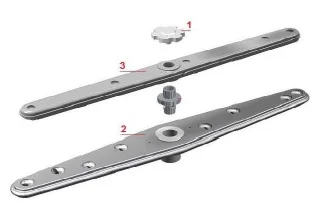
Clean the outside of the machine with neutral soap and a damp cloth. Rinse and dry carefully.
Prolonged inactivity
If the dishwasher is not used for a relatively long period, it is necessary to drain the detergent and rinse-aid dispenser in order to avoid crystallization and damage to the pump. Remove the suction tubes from the detergent and rinse-aid containers and place them in a container filled with clean water. Perform a few wash cycles and drain the machine completely.
Finally, turn off the main switch and shut the water supply faucet. The detergent and rinse-aid suction tubes should be inserted in the containers when you are ready to use the machine again, but remember not to invert the tubes (red tube = detergent; transparent tube = rinse-aid).
Do not leave the machine on and inactive for long periods of time.
Troubleshooting
For more Manuals by Adexa, visit ManualsLibraryy
Adexa ADX10T Pass Through Dishwasher-FAQs
What is a pass-through dishwasher?
A pass-through dishwasher is a commercial machine designed for busy kitchens. Dishes are placed in a rack, passed through the washing chamber, and come out clean and sanitized. It is ideal for efficiently handling large quantities of dishes, glasses, and cutlery.
How do I use the Adexa ADX10T dishwasher?
Place dirty dishes in a rack, slide it into the machine, lower the hood, and press start. The dishwasher washes, rinses, and sanitizes the items. Once the cycle is finished, lift the hood and remove the clean rack.
Why isn’t my dishwasher filling with water?
Make sure the water inlet tap is fully open, the “ON–OFF” switch is turned on, the “0–1” switch is set to position 1, and the overflow is installed correctly.
What is covered under Adexa’s warranty?
Adexa provides a 12-month parts-only warranty. It covers defects in materials or workmanship but does not include broken or damaged glass, gas refills for refrigerated equipment, or wear and tear from normal use.
What are common dishwasher problems?
Common issues include leaks or poor drainage, dirty or cloudy dishes, foul odors, and malfunctioning water valves or soap dispensers.
How do I know if the water inlet valve is clogged?
Signs of a clogged valve include slow or incomplete filling, water leaking when the dishwasher is off, and inadequate water during a wash cycle.
Can I use dishwasher pods instead of liquid detergent?
Yes, dishwasher pods are designed to dissolve in the dispenser and are effective at preventing white film buildup. They should be placed in the dispenser unless your manual says otherwise.
Can I run the dishwasher with a broken soap dispenser?
You can manually add detergent if the dispenser is broken, but for the best performance, it is recommended to repair or replace it.
What should not go in the dishwasher?
Avoid placing non-heat-resistant plastics, silicone items on the bottom rack, or any items that may be damaged by water or heat.
Is it cheaper to use a dishwasher or wash dishes by hand?
Handwashing may save electricity, but it often uses more water. A dishwasher, especially an energy-efficient model, can save time and water over the long term.
How long does a dishwasher last?
The average commercial dishwasher lasts around 8 to 12 years, depending on usage, maintenance, and water quality.
What are the top tips for using a dishwasher efficiently?
Load dishes properly without overcrowding, use eco-mode when available, clean filters regularly, check water valves, and only place dishwasher-safe items inside.

